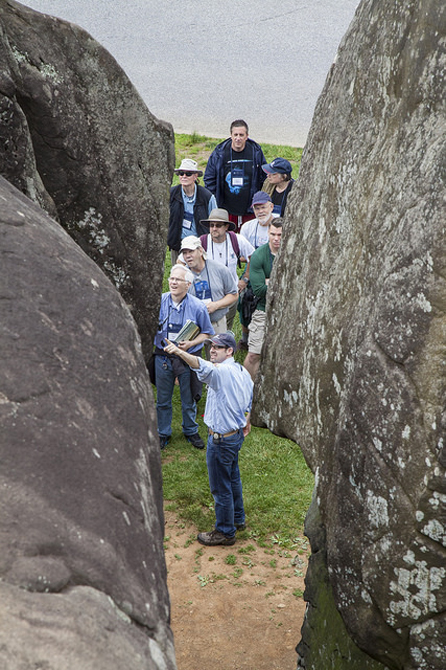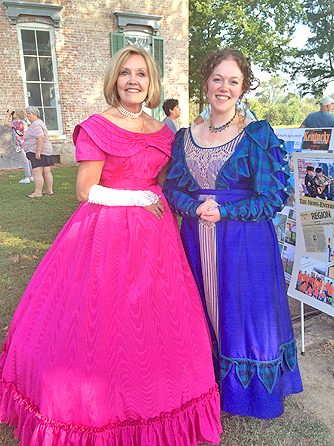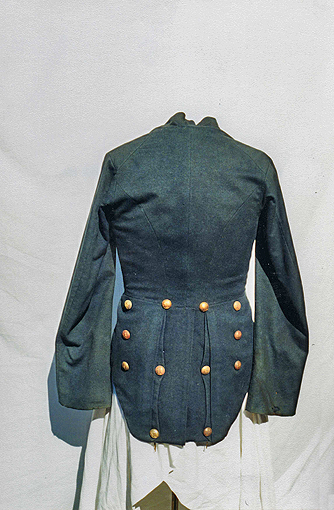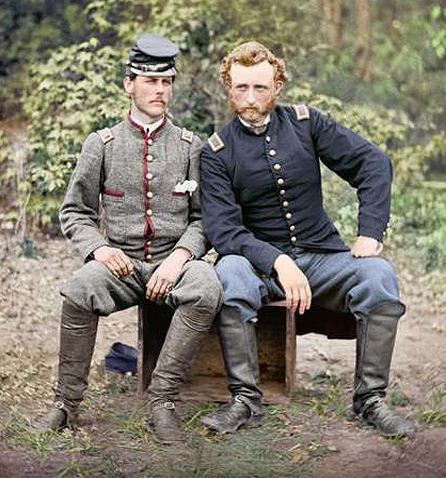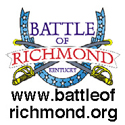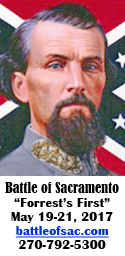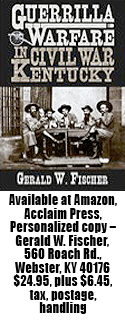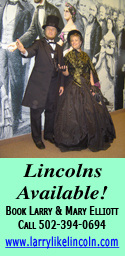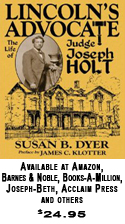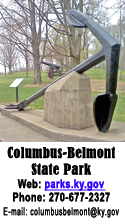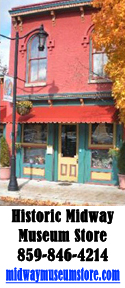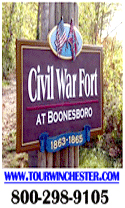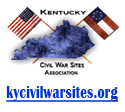|
South Carolinian’s bill would provide
national park status for Fort Sumter
Tim Scott, the first black U.S. senator from the Deep South since Reconstruction, is proposing that the site where the Civil War began be raised in status to that of a national park.
The Republican has introduced a bill creating the Fort Sumter and Fort Moultrie national park as the nation’s 60th national park and second in South Carolina.
Fort Sumter, on Charleston Harbor, was bombarded by Confederate guns on April 12, 1861, a fight that started four years of civil war. Moultrie, on nearby Sullivan’s Island, is where American patriots turned back a British fleet trying to capture Charleston days before the signing of the Declaration of Independence. More
View from both sides…
It really wasn’t a ‘Civil War,’ spokesman
for SCV’s Confederate Library maintains
It’s a misnomer to call America’s pivotal internal conflict the “Civil War,” according to a spokesman for the Florence (Ariz.) Confederate Library.
“I try to explain to youngsters and other people that civil wars are fought by two factions trying to take over a country,” Bookard Dooley maintains. “This was a war of secession and revolution in which the South wanted to leave the United States.”
Calling it the “war between the states” isn’t quite right either, Dooley continued.
“The war wasn’t between the states; it was between two entities, two governments.” More
Michael Byerley…
Knoxville photographer does at all –
great pictures, cavalry impressions
It all started for photographer Michael Byerley at the Battle of Franklin (Tenn.) with a little help from his young son.
“I’ve always had an interest in the Civil War,” Byerley explained, “but it was my son, Christian, who got me into photographing events. When he was in second grade, he asked me about the Civil War and wanted to learn more about the subject. At the time I was not aware of re-enacting and began researching and looking for different events. I ended up taking him to the 140th re-enactment of Franklin. I was absolutely amazed with what I saw and I have to say that is when I caught the bug.” More
With color and skill, Festival Dancers
gaining popularity at Ky. Civil War events
Pretty young girls in beautiful Civil War-era gowns immediately attract attention at re-enactments and living history events.
And when you couple them with young men in military or civilian attire of the period and they perform dances of the era, a crowd immediately forms.
The group is called the Berea Festival Dancers and the 30-member organization, equally divided between males and females, is fast gaining a reputation for adding authenticity and color to Civil War venues across Kentucky. More
Holt Home Community Day attracts
record crowd of more than 3,000
The Friends of the Holt Home chair summarized it best.
“The Holt Home is our compass, a link to our past and our gift to the future.”
Susan Dyer’s remarks were made at the 8th Annual Holt Home Community Day, as a record crowd of more than 3,000 attended the Sept. 24 event.
The Joseph Holt Home, circa 1850s, was built by the nation’s first Judge Advocate General, who gained fame as the prosecutor of President Abraham Lincoln’s accused assassins. The Holt Home and surrounding 19.5 acres were acquired by the Breckinridge County Fiscal Court in 2008. More
Custer’s time in Elizabethtown was
better than his Montana last stand
George Armstrong Custer always will be best remembered for his ill-fated battle with the Lakota and Cheyenne Indians in Montana.
Custer’s Last Stand earned the New Rumley, Ohio (Harrison County) native a prominent place in U.S. history, but not in the positive manner he desired. His reputation during his two-year assignment in Kentucky – although not as colorful – cast him in a more acceptable light.
The flamboyant Custer was the youngest Civil War brigadier general in the Union Army at age 23, and, by the war’s end, he commanded the 3rd Cavalry Division under Gen. Philip Sheridan. Though he attained the rank of Brevet Major General of Volunteers, Custer’s rank in the Regular Army line was only captain. When the army was reorganized in 1866, he was promoted to lieutenant colonel of the newly formed 7th Cavalry. In 1871, the 7th had been on active duty for five years, engaged in fighting hostile Indians on the western plains. More
Washington found it’s good
to have war-time friends
May 31, 1862, would not be a favored day for Lt. James B. Washington.
The Battle of Seven Pines, Va., saw the Federals overcome the Confederates and Lt. Washington, an aide-de-camp to the South’s Gen. Joseph Johnston, was among those taken captive.
Washington, a descendant of President George Washington and a native of Baltimore, had graduated from the U.S. Military Academy and had embraced the Confederacy at the outbreak of the Civil War. He received a commission that made him a lieutenant in the Provisional Army of Virginia (PAVA) and subsequently was assigned to Gen. Johnston.
But all was not lost for prisoner Washington. A captain in the U.S. 5th Cavalry – George Armstrong Custer – learned of the Confederate’s fate and requested that Washington be his aide during his time in captivity.
Washington and Custer had been friends and classmates at West Point. More
|
|
|
Civil War’s deadly firepower included
variety of pistols, rifles, field artillery
From handguns to field artillery, the Civil War had its share of deadly weapons.
Named after Napoleon III of France, the Napoleon Light Field Gun was a muzzle-loaded smoothbore cannon that fired a twelve-pound round. A mature design with design roots in French artillery, it was considered safe and reliable, its physical size a good compromise between mobility and killing power.
The Napoleon was used by both sides during the war. It could fire solid metal shot, explosive shells, and grape and canister rounds. The barrel was 66 inches long and had a bore diameter of some four and half inches – about the same as the main gun on an Abrams tank. The entire gun and two-wheel mount weighed 2,350 pounds.
The Model 1857 had a range of 1,619 yards. It could fire up to four shotgun-like canister shots per minute, making it deadly against massed infantry at short ranges.
The top-five list of deadly weapons also included the Springfield Model 1861 rifle, the Henry repeating rifle, the LeMat pistol and the Gatling Gun. More
Bugle Briefs ...
New Boyle Civil War Trail brochure
now available to assist in viewing sites
The Boyle County Convention and Visitors Bureau recently released a Civil War Trail brochure to help engage visitors in touring the historical trail and sites in Boyle County.
Boyle County is known as the birthplace of the Commonwealth. It is well known for its rich history being the site of the conflict at Perryville, the largest and bloodiest Kentucky battle during the Civil War. It is also the home of Constitution Square where the Kentucky Constitution was signed.
With the Civil War Trail brochure that is now available, Convention and Visitors Bureau Executive Director Jennifer Kirchner said she hopes to see more people come out to the trail and take advantage of the opportunity to experience history in a new way.
The brochure is available at the visitor’s center at Grayson’s Tavern in Constitution Square. More
Recovered Belle Boyd Confederate flag
sold for $50,000 at auction in Dallas
Northern newspapers described her as “The Siren of the Shenandoah” and the “Cleopatra of the Secession.”
Isabella Maria Boyd – more commonly known as Belle Boyd – was one of the Civil War’s most colorful characters. An ardent Southern patriot, the Virginia-born Boyd used her feminine wiles in the service of the Confederacy during the first two years of the War before being discovered and arrested as a spy after Union troops overran parts of Virginia.
When Confederate Gen. Thomas J. “Stonewall” Jackson’s troops occupied Front Royal, Va., and prepared to defend it in May 1862, Boyd supplied the general with valuable information about Union troop strength and reportedly even helped Jackson to plan his battle strategy. According to her memoirs, she played a prominent role in the fight, appearing on the front lines to cheer and encourage the Confederate soldiers. More
KMI produced generals …
Kentucky provided Civil War leaders
from nation’s two oldest private institutes
In 1843, Robert Thomas Pitcairn Allen and his wife, Julia, purchased the Franklin Institute, located six miles south of Frankfort on the Lawrenceburg Pike.
Several years later in 1845, Allen, a West Point graduate, changed the name of the school to the Kentucky Military Institute (KMI). The Baltimore County, Md., native obtained the school after serving as chair of mathematics and civil engineering at Transylvania University in Lexington.
After his active army duty, Allen had become an ordained Methodist Episcopal minister, but was dedicated to making Kentucky military education a success.
On Jan. 20, 1847, Allen managed to secure a Commonwealth charter, and, on Feb. 25, 1847, the Western Military Institute opened in Georgetown. Kentucky had now had the distinction of having the two oldest private military preparatory schools in the United States. More
Bugle book review …
Morgan’s raids and much more about
Civil War Cynthiana, Harrison County
Author William Penn must be exhausted. His new book, Kentucky Rebel Town, is not only complete about John Hunt Morgan’s raids in Cynthiana, but is chock-full of sidebar items about people and places in the city and county who suffered through the pains of the Civil War.
Penn deserves an “A” for his research and another “A” for his skill in effectively pulling the story together. The reader must wonder how much patience and how many sleep-deprived nights were required to develop a book that provides an in-depth perspective of the human side of war.
In his introduction, the author notes that he attempted to explore the effects of the war on all segments of the civilian population. He accomplished that. More
Kentucky’s Civil War leaders …
Shackelford was glad to see him, but
Morgan couldn’t return the compliment
Union Gen. James M. Shackelford made his Civil War claim to fame during the summer of 1863. That’s when he effectively ended Gen. John Hunt Morgan’s raids, capturing the Kentucky cavalry giant near Lisbon, Ohio.
Shackelford, a native of Lincoln County, studied and practiced law until the outbreak of the Civil War. He raised the 25th Kentucky Regiment of Infantry and was made colonel of the regiment. He was in the engagement at Fort Donelson, but lost his health and was obliged to resign his office in 1862.
Some time afterward, President Abraham Lincoln issued him special orders to raise a regiment of cavalry for Union service, which he accomplished in four weeks, choosing 1,200 first-class men who embodied what was known as the 8th Kentucky Cavalry. About this time, another Kentuckian – William Davenport – went to visit President Lincoln, and, on gaining an audience, stated his business:
“I have come to know if you would like to have Gen. (John Hunt) Morgan captured?” Davenport asked. More
|
|
|


